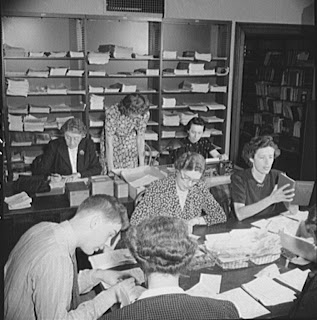Let’s role play. Imagine that you are a scientist
participating in a collaborative research project. Your whole life you dreamed
of being a part of a high performing team whose contribution leads to a
revolutionary discovery fundamentally changing what humans know.
Perhaps the discovery is health related. Perhaps the
discovery connects humanity in new ways. How do you work? What does your daily
work routine look like? How do you collaborate? What tools do you use? When and
where do you best think? Do you have enough reflection opportunities? Do you
experience intimacy of the mind as you feel assumptions shift?
How does technology help you do your job better? Are you
using technology to the fullest to achieve your best? Do you know how advances
in computing will improve and threaten your existing habits of mind? Chances
are the people below could not imagine how computing would one day manage the
types of translations they volunteered to make.
 |
| Washington, D.C. Volunteer translators in the Red Cross district library
translating messages from many foreign languages: Dutch, Polish, German,
French, Italian, into English so that they can be censored before going to
relatives in this country The Red Cross handles messages between people in
foreign countries through their Foreign Inquiry Service http://www.loc.gov/pictures/resource/fsa.8d21281/ |
When do insights occur? How well are they captured? How is scientific inquiry and influence affected at a distance when stakeholders are among different agencies?
Now imagine that you can participate in real-time scientific discovery as a citizen scientist by simply turning on your 3d home theater to a particular channel. Big data flows into your home, around your body and you are connected to biological, chemical interactions that are tested. Perhaps you can choose which experiments to observe. Imagine how this redefines Reality TV!
My project for CTU’s Web Science and Technology class, led me to find out how some scientists are prepared to use advanced collaborative software. How is research performed at a distance with others who have vastly different expertise? Is the assumption that since people have advanced degrees that they inherently can figure out how to use technology to collaborate?
This week I am attending the TeamSTEPPS National Conference in Dallas. http://teamstepps.ahrq.gov/nationalconference.htm It is a conference sponsored by the U.S. Department of Health & Human Services and is all about teaming using a health care model. While the conference is not about inquiry and research, it is about collaboration. For my job, I am assisting in the creation of an innovative program that focuses on Interprofessional Collaborative Practice involving nurses and other healthcare professionals. The topic is timely due to the government regulations on health care reform. A faculty member whom I am working with on this initiative was a former president in the Society for Simulation in Healthcare https://ssih.org that capitalizes on learning from mistakes and customizing evaluation. Simulation technology is becoming used more for inquiry such as in transdisciplinarity.
Check out my curated topic via the web 2.0 software tool Scoopit:
